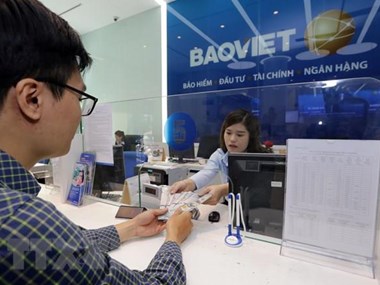 |
Insurtech has created revolutionary changes in recent years. Information technology is being applied at every stage of the insurance value chain, from market research and product design to risk assessment, advertising, sales, after-sales services, and claims payment. Operational efficiency and service quality have therefore been improved. Many businesses have moved to eliminate paper and cash in processes and transactions. Claims processing times for certain simple insurance policies has been shortened from a few weeks to a maximum of 15-30 minutes.
In the market, many new modes of sales cooperation and premium collection between insurance companies and e-commerce tech companies have also appeared. For example, the premium collection service of MoMo and Timo e-wallet for Phu Hung, Bao Viet, Prudential, and Cathay offers discounts on insurance premiums for those who buy health insurance and travel insurance on MoMo.
Insurtech also entails the emergence of new insurance intermediaries, which are websites that collect, analyze and compare products of different companies in terms of price and coverage, among others. Customers can proactively and quickly choose products and companies that best suit their personal and family needs with just a few clicks.
In addition to the large investment made on building or acquiring software systems, much has also gone towards system and process changes that require staff training. Those who have insurance expertise are mostly older, so it can be difficult for them to adapt to new technology.
Insurance companies are having to spend on young-but-tech-savvy personnel to coordinate with insurance experts in building insurance products that apply modern technology but still comply with insurance management regulations.
Some simple and low-priced products are set to be distributed only via digital channels in the long run. Such a change will lead to conflicts between traditional agent channels and digital channels, as agents lose part of their commissions from selling these products.
Cyber risks and customer information protection are also of concern. When business activities become increasingly dependent on technology, companies will have to face the risk of network attacks, system crashes, and customer information theft, and so on.
Insurance is a conditional business, subject to strict supervision by the State. Insurtech has grown too quickly. The lack of or slow amendment to State regulations on insurance management could hinder insurtech insurance products because companies cannot prove their legitimacy.
Life insurers are using technologies to approach customers as they try to digitalize the whole customer experience, from becoming life insurance purchasers to the claims process, so as to make all of the experience better.
From the consumers’ perspective, if you approach life insurance companies nowadays they all have apps on smartphones, where you can just log on and see what is happening with your policies, how much you have paid, what the accumulated interest is, or what benefits there are. In the past, before technology, it was like a hidden investment, where you’re not sure what’s happening with your money. Things are more transparent now thanks to the digital revolution.
From the perspective of insurance companies, they try to provide electronic answers to agents, which makes the life of agents easier, and they also try to have mobile apps for a better customer experience. Life insurers in Vietnam have also gone further in partnering with e-commerce platforms like Tiki and Lazada or fintechs like Momo and Timo to distribute products through these channels, because they could find potential customers and understand well their shopping behavior. They’re also going to shake hands with pharmacy chains soon.
There are only a limited number of such large online platforms in Vietnam at the moment, so life insurance companies are pushing to seize this new opportunity as fast as they can. For the time being, I’m not sure how much revenue the online sales channel can generate for life insurance companies.
However, all leading life insurers in Vietnam are seeing certain achievements on their digital transformation journey. For example, AIA has provided app and interactive business support on point of sale (iPOS) systems and digital services. Many other life insurers in the market such as Prudential, Manulife, FWD, and others have an agent sales portal via iPad and a customer portal with the same functionalities as AIA to some extent.
As Vietnam’s insurtech revolution is still in its early stages, major life insurers in the country are increasingly focusing on and making more investments in digital transformation in order to change customers’ mindsets about purchasing insurance products. So, it will take more time for people to start paying substantial amounts of insurance premiums through digital channels.

Vietnam’s life insurance market has experienced double-digit growth over the past five years. And the Vietnamese economy is expected to grow further in the next few years, with many important trade agreements to go into effect this year, including the Comprehensive and Progressive Agreement for Trans-Pacific Partnership (CPTPP) and the EU-Vietnam Free Trade Agreement (EVFTA). With increases in household incomes, more Vietnamese can afford to buy life insurance products or solutions.
Vietnam has a young population. The number of Vietnamese people using the internet and technology devices such as smartphones is huge. Life insurers can use insurtech to develop solutions to reach more potential clients and increase insurance penetration. Insurtech can also help to simplify insurance procedures significantly, to make it more efficient and easier for customers to understand insurance and the policies purchased. We see customer journey analytics being used to improve insurer/client interactions and to deliver more relevant and highly-tuned content and offerings. Mass data enrichment and improved customer data management are also enabling “no questions asked” or “few questions asked” sales processes.
We expect that the growth in life insurance in Vietnam in 2019 and 2020 will continue and exceed over 20 per cent. In 2020, it is expected that the new Law on Insurance will be presented to the National Assembly. This new law will restructure Vietnam’s insurance market and help to develop it further, especially in bancassurance. It will set certain conditions for life insurers, including solvency requirements, and enhance the business operations’ management of capital in accordance with a risk-based management model.
It will take time for insurers in Vietnam to apply and implement insurtech in their businesses. It will also require enormous resources in IT systems and technology to develop insurtech solutions. Insurtech will be one of the drivers of growth in the life insurance market in Vietnam in the future, especially in bancassurance.
Vietnam is a very interesting market, with a young population and high penetration of mobile and internet. Insurance companies like Sun Life are trying to use these factors to get closer to clients, either by offering simple products that can be purchased online or digitalizing interaction points with clients through self-service portals, mobile apps, and payment options.
The next wave of the industrial revolution is all about effectively using one key ingredient: data. Life insurers can use this ingredient to provide the best offerings and service to clients at the right moment of their lives, empower advisors and agents with insights to serve clients better, shorten or automate decision making, and increase straight-through processing to reduce waiting times for clients.
The true benefit of digitalization is through an end-to-end digital and paperless / contactless experience for clients. While Vietnam has gone a long way towards building a digital environment, there are opportunities such as digital KYC, digital signatures, and cashless payments, etc., that can further fuel a truly digital experience for our clients.
Vietnam’s life insurance market is one of the most promising in Asia. In the last ten years we witnessed double-digit premium growth. Against a background of backlog demand, demographic change, and the emergence of a middle class, we are confident that this growth dynamic is going to persist and expect life insurance penetration to increase to more than 3.0 per cent by the end of the next decade; comparable to the levels we see today in Thailand and Malaysia.
There are many challenges, from strong competition to new technologies like AI. But the most important challenge - and often the most underestimated - is the cultural dimension of insurtech. It’s not simply another technology; the way management and employees think and act has to change too. It’s all about true customer-centricity; it’s a cultural revolution.
Given the long-term horizon of the life insurance business, a stable legal environment and a strong regulator to guarantee the sustainability of the life insurance sector in the long run are crucial for insurance providers and their customers.
Insurtech trends will on the one hand improve internal efficiency, empowering insurers to react to changing customer demands more quickly, while the smart use of data allows insurers to develop individual products for the individual needs of their customers. On the other hand, insurtech trends will offer new ways to communicate with the customer. New distribution channels will enable insurers to reach new customer groups like internet-affiliated young adults or customers in more remote areas, for instance.
The insurtech trend will certainly contribute to the dynamic development of Vietnam’s life insurance market and thus the further increase of insurance coverage among Vietnam’s population. The new technologies enable insurers to develop tailor-made products in order to serve the specific needs of their Vietnamese customers. They also facilitate consumer’s access to insurance information and products. VN Economic Times

Insurance firms and agents face higher qualifications bars
Insurance companies and their agents face stricter scrutiny as a number of Government decisions designed to regulate agents’ qualifications are set to take effect in November.

More than 10 million Vietnamese still left out of health insurance
More than 10 million people were yet to be covered by health insurance as of May 2019, it was reported at an online discussion on sustainable development of health insurance held by the Government portal on June 25.
 Technology is set to change the face of the insurance industry, analysts said.
Technology is set to change the face of the insurance industry, analysts said.